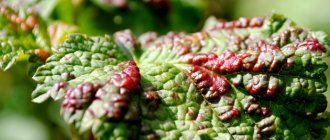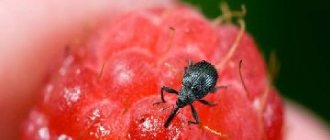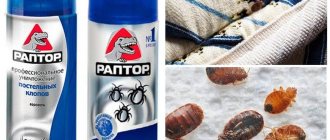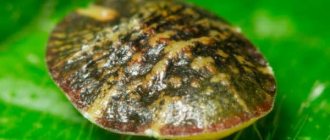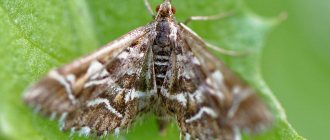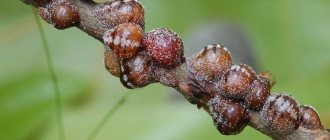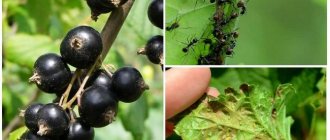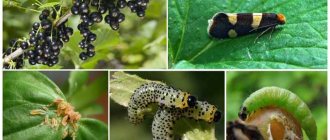Description of the pest
The glasswort is a medium-sized butterfly with a thick body and long legs. They are distinguished by a variety of colors, some species resemble in appearance. All butterflies have narrow transparent or translucent wings with an orange border and black veins. Wingspan – 10–50 mm.
The eggs are round, slightly flattened or oval, yellow-brown or black in color.
larvae are white or gray-white caterpillars up to 0.5 cm long with a pair or two pairs of legs. pupae with spines on the abdomen.
The family includes more than 900 species, 45 of them live in Russia. The most common are: poplar glass, apple glass, raspberry glass, currant glass .
After the end of flowering of trees and shrubs, butterflies lay one or several eggs on branches, roots, soil, and in cracks in the bark. The fertility of females varies, ranging from 50–1800 eggs . 2 weeks after laying eggs, offspring appear.
The caterpillars quickly penetrate the stem. There they live and feed until next year, gradually moving towards the base of the stem.
With the arrival of warm May days, the caterpillars emerge and pupate. This new generation of butterflies is ready to reproduce. They love the sun and fly near food plants during the day. The activity of adult butterflies ends when the harvest ripens, and the full development cycle of each generation takes 1 year.
How to deal with raspberry pests
There are various methods of controlling raspberry pests: through treatments with special preparations that destroy insects, agrotechnical methods, and also folk remedies. The choice of control method depends on various factors, but you should always take into account that prevention is never superfluous.
Types of pest control products
To control pests, raspberries, like any other cultivated plants, can be treated with biological and chemical preparations. Currently there is a large selection of them.
It is preferable to use biological agents, since they are less toxic or completely safe for humans and do not accumulate in fruits.
The essence of the biological method of controlling plant pests is to use the natural phenomenon of superparasitism or antagonism between microorganisms living on plants or in the soil. The natural enemies of insects and mites are various microorganisms, including pathogens of bacterial, fungal and viral diseases of insects and plants.
Bioinsecticides act on groups of insect pests, and bioacaricides act on mites. There are drugs that are effective against both insects and ticks, they are called insectoacaricides. These include Aktofit and Fitoverm. The last treatment with biological products can be carried out shortly before harvest. Biological drugs have their disadvantages. Their shelf life is short; in liquid form they can be stored from two to eight weeks. They also require special storage conditions. The frequency of treatments with biological products is higher than when using chemicals (every 7–20 days depending on the drug); in case of significant lesions, they may be ineffective.
Since biological preparations have low toxicity or are completely safe for humans, the last treatment can be carried out shortly before harvesting
The use of chemical insecticides (a type of pesticide designed to kill insects) is more effective, but also less safe for humans and animals. The vast majority of chemicals are highly toxic, so when using them you must strictly adhere to the dosages, timing of use and precautions specified in the instructions. Typically, chemical drugs have a significantly longer waiting period than biological drugs; it can vary from 20 to 60 days depending on the drug.
When treating plants with chemicals, it is necessary to take precautions and spray the plants only at certain times (taking into account the waiting period)
How and when to treat raspberries against pests
If you need to treat raspberries against pests, it is important to choose the right product. There is quite a wide variety of them. To ensure maximum protection of plants from pests and at the same time obtain products that are safe for health, it is better to use chemical and biological preparations in combination.
It is important to choose the right product for pest control; do not overuse chemicals if you can get by with biological products
Treatments must be carried out within the recommended time frame, otherwise they may not be effective. The treatment calendar is compiled depending on the stage of the plant’s seasonal life cycle.
Table: biological and chemical preparations for raspberry pest control and processing times
| Pest | Chemicals | Terms of treatment with chemicals | Biological drugs | Terms of treatment with biological preparations |
| Raspberry stem gall midge | Spark Double effect, Fufanon, Kinmiks CE, Alatar, Actellik | Flight and egg laying period | Fitoverm, Aktofit | During the growing season |
| Raspberry nutcracker | ||||
| Raspberry shoot aphid | Spark Double effect, Fufanon, Kinmiks KS, Actellik, 0.3% karbofos emulsion, 15% phosphamide emulsion | During the emergence of larvae from eggs and their transition to blossoming buds | Fitoverm, Aktofit, Mospilan | |
| 1% DNOC solution, 3% nitrafen solution | In early spring before buds open and in late autumn after leaves fall | |||
| Raspberry weevil | Spark Double effect, Fufanon, Kinmiks KS, Alatar KS, Inta-Vir, 0.3% karbofos emulsion | In spring (before flowering) and in August (after harvesting during the period when young beetles of a new generation appear) | Actofit, Lepidotsid, Mospilan | |
| Raspberry beetle | Spark Double effect, Fufanon, Kinmiks KS, Alatar KS 0.2% karbofos emulsion | Period of bud development (before egg laying) | Aktofit, Mospilan | |
| Raspberry stem fly | Spark Double effect, Fufanon, Kinmiks KS, 0.3% karbofos emulsion | The period of flight of flies before raspberry flowering: spraying young shoots and soil | Aktofit | |
| Raspberry bud moth | In early spring, before the buds open, spray (abundantly) in the areas of the lower part of raspberry shoots and during the migration of caterpillars from wintering sites (with 5-10% of the shoots populated) into the swelling buds | Actofit, Lepidotsid, Mospilan | ||
| Spider mite | Iskra Double effect, Fufanon, Kinmiks KS, Actellik, Phosfamide, Metaphos, 0.3% karbofos emulsion, lime-sulfur decoction with a strength of 0.5–1°, 1–1.5% colloidal sulfur | In the spring before the buds open | Fitoverm, Vermitek | |
| Raspberry glass | Spark Double effect, Kinmiks KS, karbofos | In the spring before the buds open | Nemabakt, Mospilan | |
| Raspberry cutworm | Spark Double effect, Fufanon, Kinmiks KS, Actellik, Inta-Vir, karbofos | Preventive spraying in the spring when leaves bloom and after harvesting to destroy caterpillars | Lepidocide, Mospilan | |
| Golden raspberry cutworm |
Video: combating the most common raspberry pests
What does the affected plant look like?
Butterflies from the glassweed family enjoy a variety of plants. They damage apple, pear, plum, cherry, apricot, quince, hawthorn, raspberries, currants, gooseberries, and blackberries . The pest settles on poplar, willow, birch, ash, linden .
No varieties that are relatively resistant to the pest have yet been developed. On perennial plants, glassware can damage 10–50% of the branches.
In the first year, damaged bushes and trees do not differ much from healthy ones. Only a lot of small leaves grow, and the berries on fruit crops become smaller. The following spring, damaged shoots after flowering and during the formation of berries begin to wither and dry out. .
If you cut such a branch, you will see a black core at the cut site . On a longitudinal section, the pest’s winding passages are visible, filled with its secretions mixed with wood debris . Sometimes dried branches, along with unripe berries, break off and fall.
On the bark, where adult insects emerge on the surface, particles of the pupal membrane remain for a short time. In some species, caterpillars live in the roots and stumps of trees.
Incredible glass butterfly.
A butterfly with transparent wings? Hardly. However, there are species that exhibit this feature. Take a closer look at the incredible glass beaker - a fascinating butterfly species that baffles science.
Advertising
Greta oto may sound like the name of a silent film star hailing from Eastern Europe, but it is actually the scientific name of one of the most graceful—and least known—butterfly species on the planet. The pride of this butterfly is that its wings, with a span of up to six centimeters, are almost completely transparent. It's true - you can practically see through them.
The common English name for this wonderful butterfly is glasswing, the Russian name is glass. It speaks for itself about the appearance of this small but unusual insect.
However, Romance languages intervene here and give this butterfly a name that, according to many, suits it better. Its Spanish name sounds like “espejitos” - literally translated as “mirror”. One fleeting glance at this insect and one can imagine how the Spaniard who gave it this name had goosebumps in a moment of inspiration.
A close-up look at Greta oto reveals that the tissue between the veins on its wings is actually translucent (one could also say that it is translucent). Most other butterflies have colored scales that create a pattern on their wings, often designed to ward off predators.
The glassfish uses a completely different method to do this, but for thousands of years it has spread these specific wings more to hide from predators than to scare them away.
The only thing that can be said about this is that its wings have dark-colored edges, sometimes even bordered with orange. If not for these edges, the glass would be almost invisible to the human eye.
The genus vitreous is part of a specific clade, that is, a group, of butterflies. And now - science, as Jennifer Aniston used to say. Clade means "branch" and is a term used in species taxonomy. When groups of species share a common ancestor (not necessarily extant), they are monophyletic. The common ancestor of glass moths is long extinct, but the clade to which they belong is known as clearwing butterflies.
Transparency in nature is not a very clear thing. To become transparent, body tissue must not absorb light. It should not dissipate it either, since this is the main obstacle to transparency. For example, people will never be able to become transparent because we contain chemical and biochemical compounds with different refractions.
Consequently, the wings of the glass must have such a refractive index that everything can be seen through them, since otherwise transparency will be impossible. There is an idea (at this point more of an assumption than a definite fact) that the surface of the wing has a coating of projections that are so small that they can be considered almost microscopic. They have the same refractive index and, since they do not scatter light, the wings become transparent.
Like most butterflies, this species looks rather fragile, but butterflies bred in captivity look quite cheerful, and their wings are no less strong than those of other species.
Another consolation is the fact that their natural habitat is nothing special. However, unless you live in South America, your only chance to see a live glassfish is to visit a glassfish farm.
However, if you want to see “mirrors” in the wild, you will have to travel - to any place from Mexico to Panama, and there you will reach your goal. You will also have to find the nearest rain forest, since it is in the lower tier of such forests that the glassworts live and thrive. They feed on the nectar of a variety of rainforest flowers, but when it comes time to lay eggs and ensure the survival of the next generation, the glassfish (figuratively) has an ace up its sleeve.
Whenever possible, the glasswort lays its eggs on a plant of the genus Cestrum. It belongs to the nightshade family and is highly poisonous. The caterpillars are striped bright purple and red (to deter potential predators) and are inedible to birds and other animals. Alkaloids (naturally occurring plant substances containing a lot of nitrogen) remain in the body of an adult glassfish, which means that butterflies will not be a tasty dish either.
During mating, which can last several hours and usually begins shortly after noon, males convert some of these alkaloids into pheromones that attract females to them.
The glasswort is also known for its long-distance migrations and the fact that males of this species perform a mating ritual on “dates.” It happens like this: many males come together to show their best qualities together - then the females choose the leader who is outwardly most exciting.
The glassfish, while not a rare species, is one of the few land animals that have successfully mastered the art of being transparent. Now you see this and see that this is not given to you.
Fighting glassware
Modern drugs
It is difficult to combat glass beetles, since the pest larvae spend most of their lives inside plants and are difficult to influence with chemicals.
It is important not to miss the time when young larvae emerge from the eggs, when they have not yet had time to penetrate into the shoots. This moment coincides with the beginning of the appearance of young leaves.
Mospilan
A systemic contact insecticide penetrates all parts of plants, quickly spreads throughout their organs and poisons the pest. After 5–7 days they die. The consumption rate of the drug is 2.5–3 g per 10 liters of water. During the season, 2 treatments are carried out, the drug protects against the pest for up to 40 days.
Golden spark
Insecticide based on imidacloprid. Well absorbed and resistant to rinsing. It is produced in liquid and powder form. If a concentrate is used to prepare the solution, then it will require 1 ml per 5–10 liters of water. When using powder, consumption rate: 40 g per 10 liters of water.
Lepidocide
Biological insecticide, safe for humans and the environment. To treat plants, 20–30 g are dissolved in 10 liters of water. Trees and shrubs are sprayed 2-3 times with an interval of 7-8 days.
Traditional methods
- Weak, dry and fading branches and shoots are pruned from plants. During the summer this should be done systematically.
- On berry bushes in the fall, shoots that have grown less than 10 cm are removed. On heavily infected bushes, all branches are cut to the ground. Healthy shoots will then grow from the roots.
- Plants with a strong odor will prevent the pest from laying eggs. In summer, trees and bushes are sprayed with infusions of onions (200–300 g of onion pulp per 10 liters of water), garlic (100 g per 10 liters of water), pine needles (200 g per 3 glasses of water), citrus peels (1 kg of peels crushed through a meat grinder per 3 liters of water). Marigolds, calendula, and nasturtium are planted between the rows. In June, when the pests pupate, the soil around the bushes is loosened and sprinkled with dry mustard, tobacco, and ash.
You can outsmart a glassfish if you know the peculiarities of its biology. In this case, chemical treatments will be of benefit. But the main efforts and time of gardeners should be aimed at prevention.
You will learn more about the fight against glassware in the video.
How to get rid of glassware
The second half of May is the summer time not only for vegetable flies, but also for glass flies: a secretive and practically invincible pest. He spends most of his life inside the shoots, where no drugs can reach him.
“Most often, glassware damages black currants, sometimes red, white and gooseberries,” says Yulia Kondratenok, plant breeder and phytopathologist of the Republican Unitary Enterprise “Institute of Fruit Growing,” Candidate of Agricultural Sciences.
— No varieties have yet been developed that are relatively resistant to this pest. You cut a branch in spring or autumn and see that its entire core is black. Or suddenly, after flowering, seemingly healthy shoots suddenly begin to wither and then dry out. This means that the glass has already worked. Sometimes it is called a stem mite, although the insect has nothing to do with mites. This butterfly is very similar to a small wasp, which has narrow glassy wings with an orange border and black veins, practically devoid of scales. Hence the name.
In May or June (depending on the weather), two weeks after the blackcurrant blooms, the butterfly begins to lay eggs. She does this in small cracks in the bark or near the buds on young branches. After 10 - 15 days, offspring appear. The caterpillars climb inside the stem, live and feed there, gradually moving (sometimes walking more than half a meter!) lower and lower to its very base. The middle of the shoot becomes black.
After the second winter, with the onset of warm May days, the caterpillar makes its move, emerges from captivity outside, where it pupates. And having already turned into a butterfly, it begins to lay eggs - up to 40 - 60 pieces. Massive egg laying occurs at the beginning of berry ripening. After 10 - 19 days, caterpillars hatch from the eggs, which bite into the branches, penetrating into their core. By the time the harvest ripens, the butterfly years are over. It turns out that caterpillars of different ages overwinter in different places: young ones - in one-year-old twigs, and adults - in woody stems.
But right now, during the active summer of butterflies, you can disorient them by spraying currant bushes with infusions of plants with a strong smell - tansy, onion, garlic, wormwood, pine needles, mint, lemon and orange peel. It is good to plant tomatoes, calendula, nasturtium, garlic, onions, and marigolds between the bushes. The aromas of such neighbors will confuse the butterfly. And if she doesn’t detect a currant bush by smell, then it means she won’t be able to lay eggs.
Throughout May and June, when the caterpillars enter the pupal stage (that is, leave their shelters inside the stems), periodically loosen the soil under the bushes, adding ash, dry mustard, shag, ground pepper or tobacco dust.
Inspect the bushes from time to time. Especially during flowering. Remove all dry and withering shoots (including 4-5 cm of healthy wood). If you find an old, diseased branch, cut it down to soil level without leaving any stump.
You can catch butterflies trying to lay eggs using all kinds of traps. Paint small pieces of cardboard, whatman paper or plywood yellow, orange or pink. Hang them at the height of the bush crown. Under them, place containers with a mixture of fermented currant jam and plain water (1:1). Butterflies, flying towards the calling color, hit a bright surface and fall into a container from where they cannot escape.
In the fall, when the currants shed their leaves, pay attention to the branches that have grown less than 15 cm. It is better to cut them out: the glass larva has probably already settled in them. Another test can be done in October–November. Gently bend or press the shoots to the ground. Healthy and elastic ones will bend, and sick ones will break.
If the glass has occupied the entire bush, radical measures will help: cut off all the branches to the base. Young healthy shoots will begin to grow from the roots, and the task will be reduced to preventing re-infection.
Glass larvae
The glass larva looks like a typical butterfly caterpillar. It reaches about 25 millimeters in length. The head of the larva is dark brown. There are paired legs on the body.
The glass butterfly is not very similar to an ordinary butterfly.
Immediately after the caterpillar is born, it climbs into the very center of the plant branch. It makes passages in thin branches and moves to thicker ones. In bad weather conditions, the caterpillar's life cycle can take 2 years.
Glassworm caterpillars eat the cores of branches. Caterpillars of the second and third instars hibernate and then begin to actively feed again. In May, some of them pupate, while others crawl into the base of the branch and overwinter a second time.
Glasswort looks more like a wasp.
The caterpillar turns into a pupa at the beginning of summer, when fruit and berry plants bloom. The development of the pupa occurs in 3-4 weeks. After which a new adult appears.
